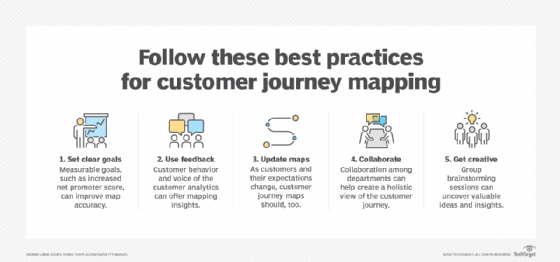Customer journey maps can offer valuable insights, but organizations should compare these maps to actual customer behavior and feedback to improve CX.
To create an effective customer journey map, CX teams should set clear goals, collect feedback from customers and regularly update their maps, among other best practices. Teams should include input from departments across the organization, third-party experts and customers into the maps, and embrace their teams’ creativity to gain new insights.
1. Set goals
A customer journey map can turn into an office ornament if team members don’t understand the map’s purpose. To start, organizations should set specific, measurable goals for the map, such as increased customer satisfaction, net promoter score and sales.
“As with any project, it’s important to set clear goals for yourself and the team,” said Nathan Gill, chief product officer at Epos Now, an electronic point of sale service.
To create their customer journey map, Gill first developed a list of questions to help guide his team’s efforts. A focused effort can help CX leaders organize their teams around shared priorities.
The initial questions that Gill and his team asked include the following:
- What do we hope to get out of this activity?
- What specific questions do we want the map to answer?
- How will we know when we’re done with the map?
2. Use customer feedback
Customer service teams should keep in mind that customer journey maps only predict how customers might interact with an organization. They offer an approximate view of the customer journey, so teams must stay open to different ways customers may progress. Quality customer feedback can help identify why customers choose a particular path, problems they encountered and factors that simplified their purchase decisions.
“It’s nearly impossible to model or predict how every individual is going to act or to successfully apply one set of rules that everyone will respond well to,” said Michael Fisher, CEO at 3Radical, a customer experience consultancy.
Therefore, organizations should solicit feedback and provide customers with different journey options. The combination of written and behavioral feedback can help CX teams know how prospects and customers interact with their organization.
“The result will be better outcomes because customers and prospects will feel listened to, not talked at, and their needs will be more efficiently met,” said Fisher.
3. Consistently update maps
Customer behavior changes as customers embrace new trends, discover competitor organizations or become more familiar with a brand. To account for behavior changes, CX teams must regularly update their customer journey maps and develop feedback loops that help update maps over time. Regular map updates can improve the accuracy and utility of journey analytics and provide deeper customer insight.
“You need to keep a close eye on your customers’ behavior and, based on this, refine your customer journey map,” said Kashif Naqshbandi, chief marketing officer at Revolent Group, a talent creation service. For example, he found that his organization started to attract new groups of customers as it grew. To effectively target these new groups, his team created new buyer personas and mapped out their journeys.
Organizations can use feedback loops to detect changes in what customers do, in addition to what they say. “Customer psychology is tricky, and people’s actual customer journeys are often different from their perceived customer journeys,” said Cornelius Fichtner, president of OSP International, a project management education service.

4. Include multiple departments
As organizations create and refine customer journey maps, they should include input from sales, customer support, development, marketing, finance and legal teams. Different customer journey phases depend on different departments.
Input from different departments helps CX teams understand how to move prospects down the sales funnel, according to Jonathan Moran, product marketing manager for SAS Customer Intelligence. Moran created a customer journey map that sought to improve how sales teams connect with leads after a global user conference.
To create the map, Moran’s team worked with colleagues from sales, marketing and other departments to learn what content, processes and timelines to include and how quickly they could execute their plan. Once complete, the map filled gaps in communications and demonstrated that marketing and sales teams needed content to persuade customers. This approach helped Moran’s team fill gaps that let prospects fall through the cracks.
5. Embrace creativity
CX teams should use collaboration tools to facilitate brainstorming sessions, according to Alexander Brown, a business consultant at Alpha GG. These sessions can help teams uncover new ways to satisfy customers and drive sales.
“It’s so much easier to let the team have fun, writing out ideas and dreams to scale back than to miss out entirely,” he said.
Brown collaborated with a team to design a customer journey map for an app that helped individuals loan out items, such as lawnmowers and dehumidifiers, to their neighbors. When they designed the first map, the team of artists, coders, designers, marketers and UX/UI experts discussed their shared vision.
Then, they split off into smaller groups and worked on different map variations at the same time, so each team created their own interpretation. Team leaders from each group then walked the larger group through their maps. Finally, the larger group identified customer personas, goals and tasks, and assembled the final version of the map to guide the app’s creation.
“Without the process, we would have missed some crucial payment gateway options, as well as completely missed a few automatically assumed features,” said Brown.
